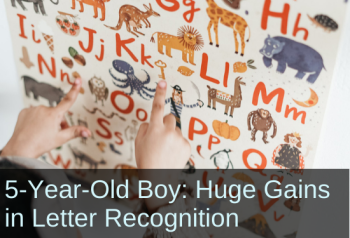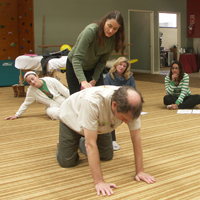5-Year-Old Boy: Huge Gains in Letter Recognition
Submitted by M.W., OT

For my first case study, I chose to work with a 5 year old boy (referred to as L throughout study). I have been seeing him for about a year for a variety of concerns, including delayed fine motor development, some difficulty with attention, and difficulty with letter recognition. His family has been becoming more concerned with his inability to identify letters as he prepares for school.
I chose to start with rhythmic movements after starting this [Brain and Sensory Foundations, First Level] course. I started one of my sessions with rhythmic movement #1. I immediately noticed that L calmed down during the movements, and stayed still for the entire time I was completing the movements, which was atypical for him.
After finishing the movements, he reported enjoying this.
At the end of the session I taught mom about the movements and talked her through them as she practiced them. I assigned mom to complete the movements at home during the week. The next week, I introduced the [Brain Tune up] activity from [Brain and Sensory Foundations course] prior to working on letters. I began doing the 5-step balance process with him with the goal of integrating reflexes.
I’ve been working with the hand reflexes the longest to help work on the poor hand strength and fine motor skills that he has been having difficulty with, and because I felt these would be an easy place for him to start learning the routine for our play with integrating reflexes. I also began working more with ATNR, as I thought this could be contributing to L’s difficulty with letter recognition. L’s family has always been very consistent with carryover in the home environment, and they have been consistently completing rhythmic movements daily in addition to incorporating any other playful movement ideas I suggest throughout the week.
I have been working with this child for approximately 6 weeks now, and I have noticed a significant change in particular with his letter recognition. Before beginning, he was starting to recognize shapes as different than letters, but had no concept of letters vs. numbers vs. scribbles on the paper. As of our last session, he is able to identify an average of 24/26 upper case letters at this time. For me, I feel that I truly learned how major of an impact these movements can have from this case.
This child has been receiving speech therapy and occupational therapy for over a year, and both services have goals related to letter recognition. While L has always made progress in therapy with some of his goals, this is one area where progress was very slow. I adjust L’s program week by week after talking to mom about how things went and seeing how he responds during sessions. L is a very happy, playful boy, so I primarily am adjusting his program by showing him and mom different ways to incorporate movement into everyday play at home.
Edited, Emphasis Added


